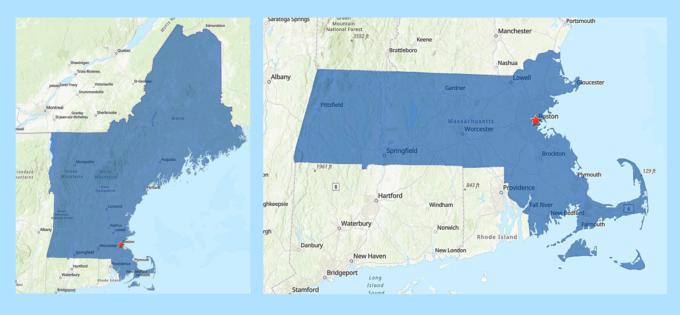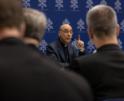
Culture
This is the second in a series of four articles about the changing geography, or better, the borders of the Archdiocese of Boston. These also focus on the Diocese of Providence, which concludes its sesquicentennial observance on June 26, 2022.
1843
The Church in the United States continued to grow, and when Hartford was made a new diocese, five other sees were created: Chicago, Little Rock, Milwaukee, Oregon, and Pittsburgh. The Church was clearly moving west, even as it swelled in the east.
The initial growth and the harbinger of continued and sustained growth in both the general and, especially, in the Catholic population of New England gave rise to the division of the New England-wide Diocese of Boston into two sees: Boston would retain the Commonwealth of Massachusetts and the northern New England states: Maine, New Hampshire, and Vermont. Hartford would serve Connecticut and Rhode Island.
The new see city was to be Hartford, Connecticut, and the new bishop, not surprisingly, was a Boston priest, Bishop William Barber Tyler. He would serve for about five years. The diocese included not only the Nutmeg State but the entire state of what was then Rhode Island and Providence Plantations.
Something unusual happened, however. It seems that the new bishop quickly realized that the new diocese had a larger Catholic population in "Little Rhody" and received permission to build a cathedral in Providence. Soon, the tiny Sts. Peter and Paul was too small for its growing population, and so the bishop began to have it enlarged.
Meanwhile, Catholic schools began to appear, although sporadically -- one in Newport in 1843 and another in Providence in 1846 -- and Bishop Tyler established two more parishes -- St. Mary, West Warwick, and St. Charles Borromeo, Pawtucket -- slight hints of things to come.
In Boston, meanwhile, there was an equal flurry of activity between 1843 and 1853. Bishop Benedict Fenwick and his successor, Bishop John Bernard Fitzpatrick, established 17 new parishes in what is today the Archdiocese of Boston. Recall that parishes established anywhere in New England until 1843 were established by either Bishop Cheverus or Bishop Fenwick. Two of these 17 new parishes were personal parishes: St. Marie in Lowell for the French Canadians; and St. John the Baptist for the Polish in Salem. The new people arriving were already flavoring the Catholic "melting pot."
A new bishop for Hartford was named, and the choice fell to the Irish-born vicar general of the recently created Buffalo Diocese, Bishop Bernard O'Reilly. To meet the growing needs of his people, the bishop went home to Ireland and sought priests to serve in his two-state see.
These years also saw the arrival of the Sisters of Mercy from Pittsburgh, who were the founding faculty of the cathedral school and nearby St. Patrick School. At St. Patrick, the sisters either replaced or augmented the previously all-lay faculty.
In the Boston Diocese, women religious were arriving. The first of these congregations was the Sisters of Notre Dame de Namur, whose sisters staffed St. Mary School in Boston's North End and the parish school at St. Patrick, Lowell.
In the coming decades, women religious would play an irreplaceable, and to this day still largely unheralded, role in the life of the Church not only in Boston and Providence but across the U.S. While primarily thought of in their connection to parish schools, the sisters also taught in high schools -- parish and private. Many established colleges, serving as faculty and administration in a time when women in the rest of American society were scarce in higher education. Health care facilities, initially hospitals and then later nursing homes, and extended care facilities served not only Catholics but everyone, regardless of religious confession or economic circumstances.
1853
Thirty new dioceses were created between 1843 and 1853 "from sea to shining sea." A further indication of the Church's expansion was the creation in that same time period of six new metropolitan archdioceses: Oregon City (now Portland in Oregon) in 1846; St. Louis in 1847; Cincinnati, New Orleans, and New York, all in 1850; and San Francisco in 1853. An additional 20 new sees were created between 1854 and 1870.
In the Boston Diocese, the growth continued. In the territory that is presently the Archdiocese of Boston, an astonishing 55 new parishes were created by Bishop Fitzpatrick or Bishop John J. Williams between 1853 and 1870.
On the national scene, the rumblings of a civil war were rising; immigrants were literally flooding the eastern seaboard, especially from Ireland, but increasingly from Eastern European countries, the nations later established out of the Austro-Hungarian Empire, and, more noticeably, from Italy. While many settled in urban areas, others went west or at least west to the mighty Mississippi. A mix of people entered through New Orleans and spread west to Texas.
In spite of the Civil War, parishes grew in number and population, and the institutional structure of the Church tried to keep pace, adding to church buildings were more schools, more hospitals, orphanages, and the inklings of the later massive Catholic Charities that still mark the Catholic Church in the United States.
In Rhode Island, then just on the cusp of becoming its own diocese, 14 new parishes were established by Hartford Bishop O'Reilly and his successor Bishop Francis Patrick McFarland.
The bishops of the New York province, which then included the Archdiocese of New York and its suffragan sees at Boston, Hartford, Albany, and Buffalo, urged the Holy See to create more dioceses to meet the pastoral needs of the burgeoning Catholic populace. In 1853, Brooklyn and Newark were made dioceses with territory previously belonging to the Archdiocese of New York; while Burlington and Portland (which then included all of Maine and New Hampshire) were separated from Boston. With that, the borders of the Diocese of Boston were contiguous with those of the Commonwealth of Massachusetts.
Within a mere 45 years, the Boston diocese geographically contracted from the six New England states in 1808, to the four "northern" New England states in 1843, and to the Commonwealth in 1853. There was at the same time expansion, especially in the immigrant population across the area and within all the New England dioceses.
FATHER ROBERT M. O'GRADY IS THE SPECIAL ASSISTANT TO THE PRESIDENT OF PILOT CATHOLIC MEDIA. YOU CAN REACH HIM AT RMOGRADY@PILOTCATHOLICNEWS.COM OR 617-779-3790.
Recent articles in the Culture & Events section
-
'Dignitas' and the mediaRussell Shaw
-
Scripture Reflection for April 14, 2024, Third Sunday of EasterDeacon Greg Kandra
-
St. Helena's House is established in the South EndThomas Lester
-
Is this synodality?Russell Shaw
-
Poking the hornet's nest of IVFFather Tadeusz Pacholczyk


















